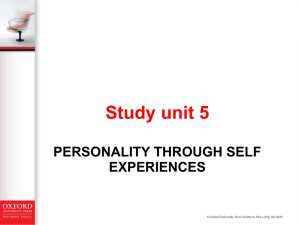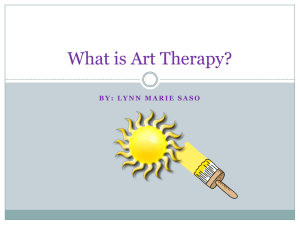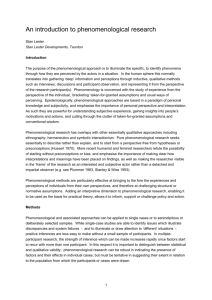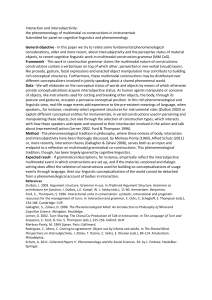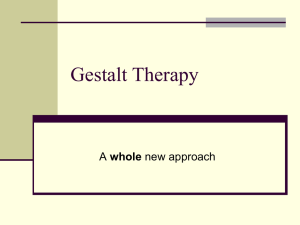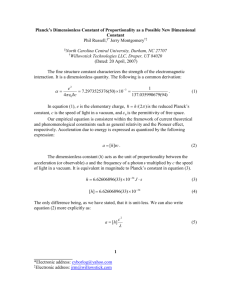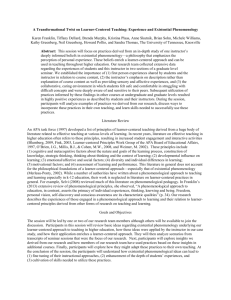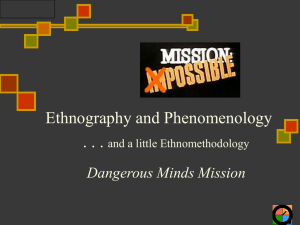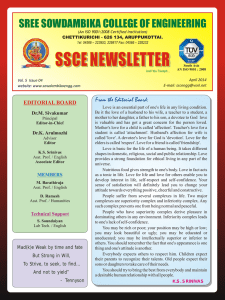phenomena approach
advertisement
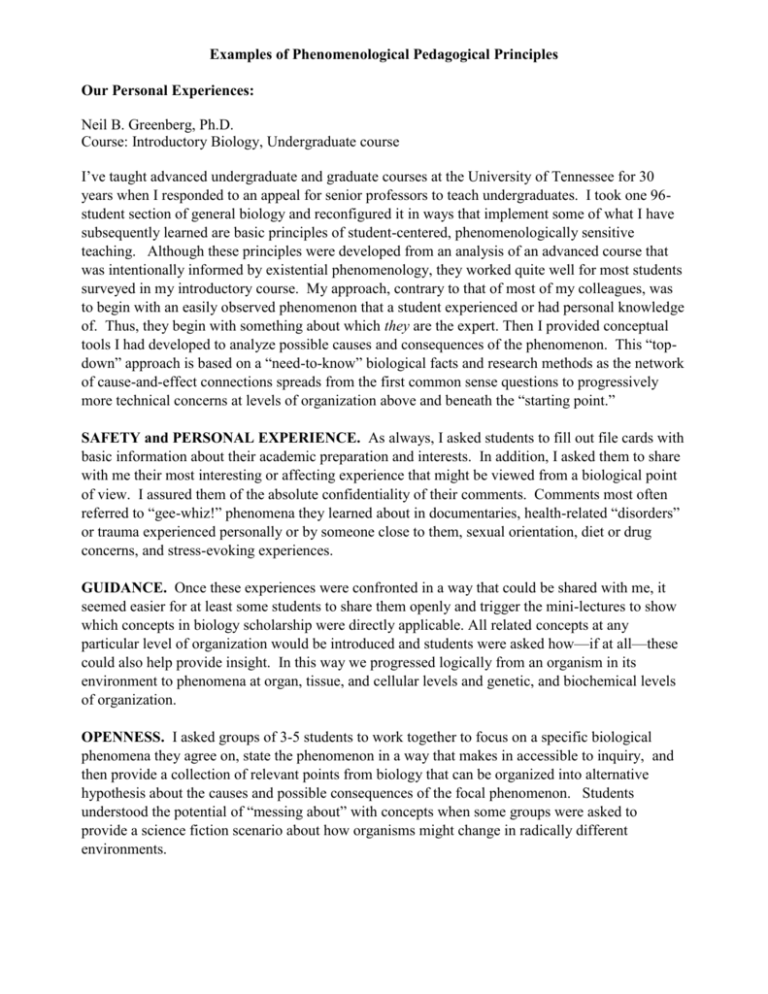
Examples of Phenomenological Pedagogical Principles Our Personal Experiences: Neil B. Greenberg, Ph.D. Course: Introductory Biology, Undergraduate course I’ve taught advanced undergraduate and graduate courses at the University of Tennessee for 30 years when I responded to an appeal for senior professors to teach undergraduates. I took one 96student section of general biology and reconfigured it in ways that implement some of what I have subsequently learned are basic principles of student-centered, phenomenologically sensitive teaching. Although these principles were developed from an analysis of an advanced course that was intentionally informed by existential phenomenology, they worked quite well for most students surveyed in my introductory course. My approach, contrary to that of most of my colleagues, was to begin with an easily observed phenomenon that a student experienced or had personal knowledge of. Thus, they begin with something about which they are the expert. Then I provided conceptual tools I had developed to analyze possible causes and consequences of the phenomenon. This “topdown” approach is based on a “need-to-know” biological facts and research methods as the network of cause-and-effect connections spreads from the first common sense questions to progressively more technical concerns at levels of organization above and beneath the “starting point.” SAFETY and PERSONAL EXPERIENCE. As always, I asked students to fill out file cards with basic information about their academic preparation and interests. In addition, I asked them to share with me their most interesting or affecting experience that might be viewed from a biological point of view. I assured them of the absolute confidentiality of their comments. Comments most often referred to “gee-whiz!” phenomena they learned about in documentaries, health-related “disorders” or trauma experienced personally or by someone close to them, sexual orientation, diet or drug concerns, and stress-evoking experiences. GUIDANCE. Once these experiences were confronted in a way that could be shared with me, it seemed easier for at least some students to share them openly and trigger the mini-lectures to show which concepts in biology scholarship were directly applicable. All related concepts at any particular level of organization would be introduced and students were asked how—if at all—these could also help provide insight. In this way we progressed logically from an organism in its environment to phenomena at organ, tissue, and cellular levels and genetic, and biochemical levels of organization. OPENNESS. I asked groups of 3-5 students to work together to focus on a specific biological phenomena they agree on, state the phenomenon in a way that makes in accessible to inquiry, and then provide a collection of relevant points from biology that can be organized into alternative hypothesis about the causes and possible consequences of the focal phenomenon. Students understood the potential of “messing about” with concepts when some groups were asked to provide a science fiction scenario about how organisms might change in radically different environments. Examples of Phenomenological Pedagogical Principles Katherine H. Greenberg, Ph.D. Course: Advanced Learning Theories, Graduate course I teach graduate courses in educational psychology and coordinate an undergraduate course in the teacher education program, which is taught by graduate teaching assistants on my instructional team. For more than five years I taught a course about designing instruction and syllabus development utilizing Weimer and Blumberg’s five dimensions of learner-centered teaching. When we analyzed our findings about student responses to a phenomenological approach, I began to fully realize its potential at an explicit level. I am now refining my approach to better utilize the principles that emerged from data. Here are some examples from my doctoral seminar on advanced learning theories. In this seminar we explored the application of seven major theories in a variety of educational environments and in relation to related research and issues in education. SAFETY. For many years I have set aside the first few minutes of every class session for Checkins. Every participant, myself included, briefly shares something currently going on in their lives that were important to them. I found it helps us know each other more than as members of a class and furthers our development of a learning community of mutual respect and trust. What I now realize is that students value my comments in response to their check-ins. Even though I strive to join students as another learner, I am more aware of my power as the instructor and their need to know of my acceptance of them as people. PERSONAL EXPERIENCE and OPENNESS. Together we selected topics for each class session. Students were expected to facilitate a part of each session by sharing their personal experience and expertise related to the given topic and their assigned learning theory as well as contribute additional scholarly material. At the end of the course, participants shared a one or two page selfassessment over of their learning during the entire course, using a creativity rubric to help them reflect on their ability to contribute to their own and others’ learning at a high level. Almost every student shared their amazement at how much they had learned to think about theories and their application in a conditional manner. While I have always tried to be open to multiple perspectives within the field of educational psychology, the phenomenological approach helped be understand the value of student autonomy in selecting and facilitating class activities that draw upon personal experiences. GUIDANCE. I selected the learning theories, two graduate level textbooks to provide background information regarding the theories, and other readings to help us structure our exploration of scholarship in this field. I shared my expectations for scholarly inquiry into the subject matter. Throughout the course, I helped students further a relaxed yet rigorous atmosphere, expanding on issues as needed to further a deep level of analysis and synthesis and inquiry into many varied perspectives. When needed, I shared information that might help them place the issues within the context of educational psychology historically and in relation to current issues that influence various perspectives. During the last five minutes of each class session, everyone recorded self-reflections, answering such questions as: What do I know now? What do I want to know now? What helped or hindered my learning? What questions do I have? I began each class with my reflection on their reflections of the lasts session. The phenomenological approach signified to students my great respect for their contribution to class and helped me better understand the balance between student and instructor. Examples of Phenomenological Pedagogical Principles Brian K. Sohn, Graduate Teaching Assistant Course: Educational Psychology, Undergraduate course In my educational psychology class, a senior-level, required class for future teachers in the state of Tennessee, we engage in an activity that I call "Launch the World." Students are to interview each other, depending on the topic, with prompts like, "Tell me about a time in school when you were especially motivated or unmotivated," for a unit on motivation or "Tell me about a time when you noticed your own growth," when we discuss developmental theories. They compare their stories and then we share with the whole class. We then pick out themes and compare the theory we have described with the theories mentioned in the textbook. I then ask students, based on our discussion, to describe practices they will employ in their future classrooms. Kristina Plaas, Ph.D., R.N. Courses: Nursing Education, various levels With its emphasis on openness and connection in a comfortable environment, principles gleaned from our experience with Dr. Pollio’s class have ready application in nursing education: 1. Clinical post-conference: Instead of asking students to talk about their patients, ask them to tell about their experience of providing care for the patient. Content learning about medications, diseases, standards, and procedures can be interjected as the student talks about what the experience was like for them. Principles of teamwork emerge as students dialogue with each other about their clinical experiences. In this non-judgmental setting, students are free to express anxiety, fear, excitement, pride, and other emotions related to caring for patients. 2. Simulated learning: Applying phenomenological principles in a controlled lab setting gives students the freedom to play with different perspectives and approaches to providing care. By collaborating with students, the instructor discovers what the students see as significant in the experience and can facilitate learning that meets specific student needs. 3. Theory: Nursing theory is often perceived as difficult to understand by students. A phenomenological approach, with its emphasis on “What” can open dialogue and facilitate clarity. 4. Research: Many research questions lend themselves to phenomenological inquiry as nurses seek to understand the patient and provider’s experience. 5. Leadership: Communication, decision-making, team-building, etc. can be effectively taught in a phenomenologically-based learning environment. Examples of Phenomenological Pedagogical Principles Examples from Review of Literature: Constantinou, P. (2011). Empowering pre-service physical educators through the planning and instruction of a novel activity unit. Strategies: A Journal for Physical and Sport Educators, 24(3), 25-28. Course: Physical Education in Teacher Education Constantinou asked future physical education teachers to design a unit based on novel international sports and games such as Korfball, Sepak, Takraw, and Tchouckball. She explained that PE teachers are generally skilled in the traditional sports and activities they teach their own students and the novel activity unit allowed these future educators to “experience what it is like to be a novice performer” in order to “better understand the struggles low-skill learners have to overcome.” Delcham, H. & Sezer, R. (2010). Write skewed: Writing in an introductory statistics course. Education, 130(4), 603-615. Course: Introductory Statistics Delcham and Sezer redesigned an introductory statistics course when they saw that their undergraduate students could complete a statistical problem correctly but still not interpret the results accurately. They added a writing component to assignments that required students to explain the experiment, problem, design, and results in their homework. This practice placed the students in the position of researcher, rather than student. From this first-person position, students experienced examples of statistical concepts, rather than merely memorizing their definitions. McCormick, T. M. & Hubbard, J. (2011). Every picture tells a story: A study of teaching methods using historical photographs with elementary students. The Journal of Social Studies Research, 35(1), 80-94. Course: Elementary Social Studies McCormick and Hubbard studied two preservice elementary education teachers who incorporated historical photographs into their social studies lessons. The photographs were selected to help elementary students connect in a more direct and personal way to the topics they were learning about in school. The authors found that historical photographs may have helped elementary grade students make personal connections with historical material, which demonstrated a student-centered approach to teaching history in the elementary grades. Examples of Phenomenological Pedagogical Principles Selvi, K. (2008). Phenomenological approach in education. In A. Tymieniecka (Ed.), Education in human creative existential planning, Analecta Husserliana, The yearbook of phenomenological research, Vol. XCV. Dordrecht, Netherlands: Springer. Courses: A variety of disciplines Selvi (2008) examined several pioneering approaches that applied phenomenological principles to pedagogy (Alerby, 2000; Louchakova, 2005; Moustakas, 1994; Selvi & Ṏztürk, 2000). In Selvi’s assessment of these examples, he explained that, “Moustakas (1994) emphasizes and focuses on individual knowledge, freedom to explore and make choices, personal vision, discovery, and selfassessment” (Selvi, 2008, p. 44). Alerby, according to Selvi, showed “how a phenomenological approach to education created conditions for genuine thoughts and ideas, which can aid in the development of the natural intelligence and creative capacity of the individual” (Selvi, 2008, p. 47). Louchakova, in Selvi’s assessment, provided students with “a training method that helps to build an aptitude for the phenomenological research method” and included a stage designed to help students focus their attention on their “inner experiences of sensing, feeling, imagining, and thinking” (Selvi, 2008, p. 45). Finally, Selvi shared his own approach to phenomenological pedagogy in a fifth-grade science class where he applied the creative drama method (Selvi and Ṏztürk, 2000). Selvi demonstrated how the discipline of phenomenology might be combined with any number of other content domains. Waltonen-Moore, S.; Stuart, D.; Newton, E.; Oswald, R.; & Varonis, E. (2006). From virtual strangers to a cohesive online learning community: The evolution of online group development in a professional development course. Journal of Technology and Teacher Education, 14(2), 287-311. Courses: Online learning communities Waltonen-Moore and her colleagues conducted a case study to learn more about student experiences as they transitioned from “virtual strangers to a cohesive online learning community.” Through the analysis of patterns in a threaded discussion board, their findings indicated that online learning communities developed in ‘stages’ that may be further supported through instructional planning sensitive to the needs of students. Each stage in the development of a cohesive learning community required instructional planning that supported learners through their present stages and helped to advance learners as they transitioned to the next stage. 6th Annual Conference on Higher Education Pedagogy Learn more about our Phenomenology in Education Research Team (PERT)
